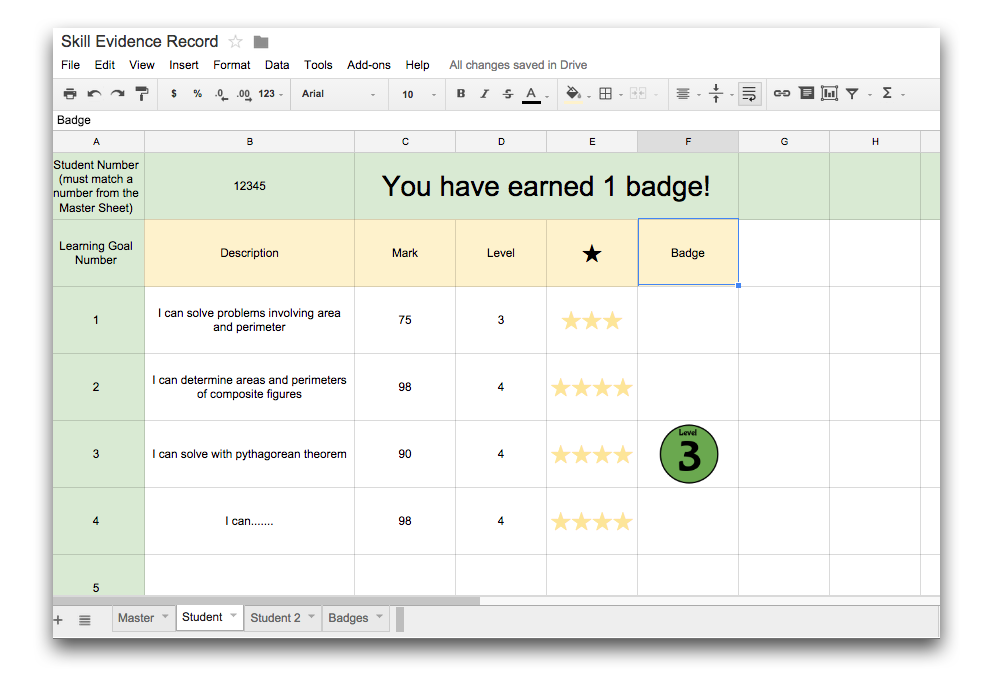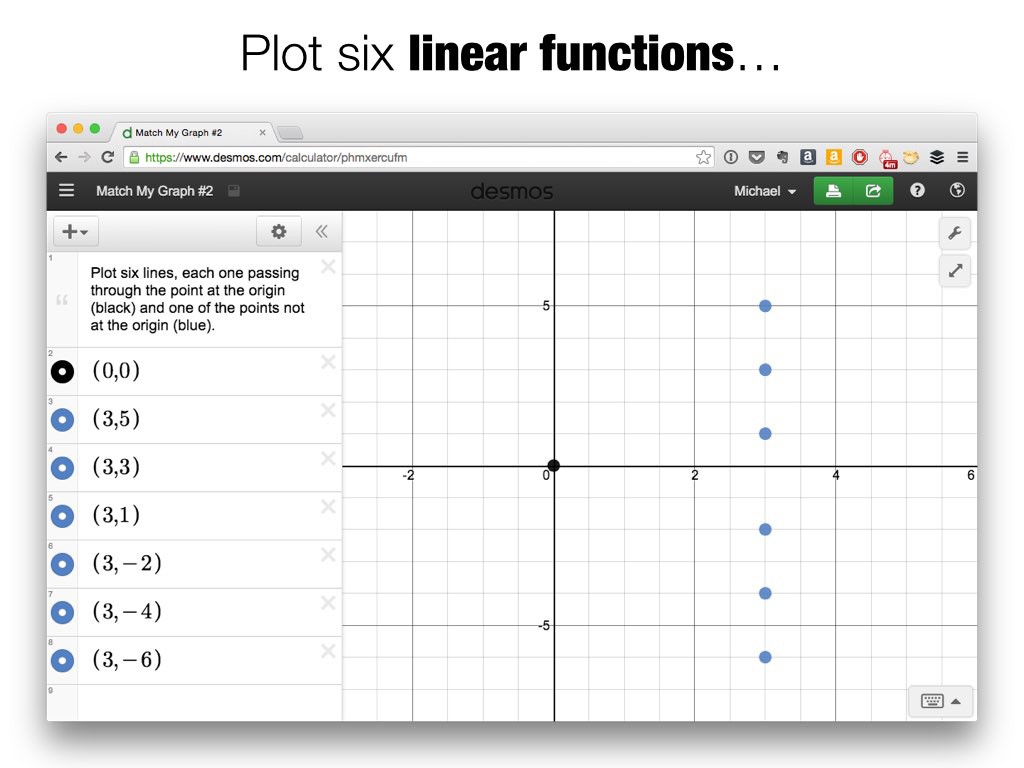 Have you heard of the Internet? How about blogs? Well if you answered yes to those two questions then you know how often one teacher will post something and then another will see it and then make it better or customize it in a different way. Some of this good collaboration has led to some really good ground work on using gamification and badges to measure assessment in math class. Jon Orr started the process and Kyle Pearce did some modifications and they look like they have a system that works really well. They are basically abandoning traditional tests for ongoing assessment of learning goals directly. But not only assessment but mastery. Then they take it all and cram it into a Google Sheets document with a page that each student has access to that has their entire practice. And then Jim Pai puts his spin on it. There is no way I can summarize it all here. Seriously, take a look at their posts to get the 411. Way to go team.
Have you heard of the Internet? How about blogs? Well if you answered yes to those two questions then you know how often one teacher will post something and then another will see it and then make it better or customize it in a different way. Some of this good collaboration has led to some really good ground work on using gamification and badges to measure assessment in math class. Jon Orr started the process and Kyle Pearce did some modifications and they look like they have a system that works really well. They are basically abandoning traditional tests for ongoing assessment of learning goals directly. But not only assessment but mastery. Then they take it all and cram it into a Google Sheets document with a page that each student has access to that has their entire practice. And then Jim Pai puts his spin on it. There is no way I can summarize it all here. Seriously, take a look at their posts to get the 411. Way to go team.Curriculum Tags: All
http://mrorr-isageek.com/?p=3629
http://tapintoteenminds.com/2015/01/24/standards-based-grading-gamified-badges/
http://intersectpai.blogspot.ca/2015/01/student-evidence-record-with-google.html
 I think sorting activities are a nice way to have students do work in a very painless (to them) way. But the painful part is often for us teachers who have to actually spend the time to create them. This is especially since the time that it takes to make the activity is often longer than it actually takes for the kids to do the activity. So I am always happy when teachers share their activities. In this one, from Miss Calculate, the sorting is about recognizing the different types of quadratic factoring. As it is right now it would be only appropriate for grade 10 academic, grade 11 university and university/college and grade 12 college. However it could be modified for other courses or be used for review in some of the grade 12 university courses.
I think sorting activities are a nice way to have students do work in a very painless (to them) way. But the painful part is often for us teachers who have to actually spend the time to create them. This is especially since the time that it takes to make the activity is often longer than it actually takes for the kids to do the activity. So I am always happy when teachers share their activities. In this one, from Miss Calculate, the sorting is about recognizing the different types of quadratic factoring. As it is right now it would be only appropriate for grade 10 academic, grade 11 university and university/college and grade 12 college. However it could be modified for other courses or be used for review in some of the grade 12 university courses.Curriculum Tags: MPM2P, MFM2D, MCR3U, MCF3M, MBF3C, MAP4C, MHF4U
http://misscalculate.blogspot.ca/2015/01/factor-sort-review.html
 I like visualizations that make people think differently about everyday items. In this set of slideshows we get a sense of how portion sizes have changed over the years. Not only would this create a good discussion about health but also a great way to talk about proportions.
I like visualizations that make people think differently about everyday items. In this set of slideshows we get a sense of how portion sizes have changed over the years. Not only would this create a good discussion about health but also a great way to talk about proportions.Curriculum Tags: Gr7, Gr8, MPM1D, MFM1P, MAT1L, MAT 2L
http://www.nhlbi.nih.gov/health/educational/wecan/eat-right/portion-distortion.htm
 Here is a really neat way to talk about unit rate. Have students answer the question: "Would you rather have a penny or a potato chip?". That is, how much does one potato chip cost?
Here is a really neat way to talk about unit rate. Have students answer the question: "Would you rather have a penny or a potato chip?". That is, how much does one potato chip cost?Curriculum Tags: Gr7, Gr8, MPM1D, MFM1P, MAT1L, MAT 2L
http://www.wired.com/2015/01/rather-potato-chip-penny/
 We have all seen the Ferris wheel type problems. This isn't much different than what you may have seen but I like the added feature of actually creating minature Ferris wheels from pipe cleaners. Now if you use something like this in grade 11 then it will probably be more along the lines as an introduction to trig functions where as in grade 12 you can go deeper since you have the use of radians.
We have all seen the Ferris wheel type problems. This isn't much different than what you may have seen but I like the added feature of actually creating minature Ferris wheels from pipe cleaners. Now if you use something like this in grade 11 then it will probably be more along the lines as an introduction to trig functions where as in grade 12 you can go deeper since you have the use of radians.Curriculum Tags: MCR3U, MHF4U
http://teachhighschoolmath.blogspot.ca/2015/01/math-is-lways-better-when-you-do-more.html
 It's such a good tool that Desmos should be a staple in every math class. And so Mary at the Making Math Meaningful blog shows us a simple way to both introduce Desmos to her Calculus kids and start the course off with some discovery.
It's such a good tool that Desmos should be a staple in every math class. And so Mary at the Making Math Meaningful blog shows us a simple way to both introduce Desmos to her Calculus kids and start the course off with some discovery.Curriculum Tags: MCV4U
http://marybourassa.blogspot.ca/2015/01/calculus-day-1.html
 And some more collaboration. This set of mini challenges from Michael Fenton is a great way to use Desmos to promote thinking and learning with linear equations and also parabolas. So much better then a bunch of worksheets. But then Mathy Cathy gets ahold of it and creates some lovely Thinglink online worksheets that compiles them all. Again, well done team
And some more collaboration. This set of mini challenges from Michael Fenton is a great way to use Desmos to promote thinking and learning with linear equations and also parabolas. So much better then a bunch of worksheets. But then Mathy Cathy gets ahold of it and creates some lovely Thinglink online worksheets that compiles them all. Again, well done teamCurriculum Tags: MPM1D, MFM2P
http://reasonandwonder.com/match-my-graph-linear-functions/
http://reasonandwonder.com/match-my-parabola/
More info on gap closing with boys. In this case a "tutoring program on steroids"
Curriculum Tags: All
To me this is a no brainer. If all you do is "Drill and Kill", that's not very effective.
Curriculum Tags: All
Curriculum Tags: MDM4U
https://www.youtube.com/watch?v=rudzYPHuewc
The Superbowl is all over but the crying. And the winners might be the viewers who got to watch all the commercials. Here is an interactive (you have to click on the link to get the interactive bit) representation of how much was spent on ads since 1995. It's kinda like a bar graph on acid.
Curriculum Tags: Gr7, Gr8, MBF3C, MDM4U
http://mycmag.kantarmediana.com/misc/SuperBowlAdTracker.html







No comments:
Post a Comment